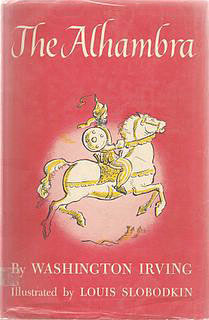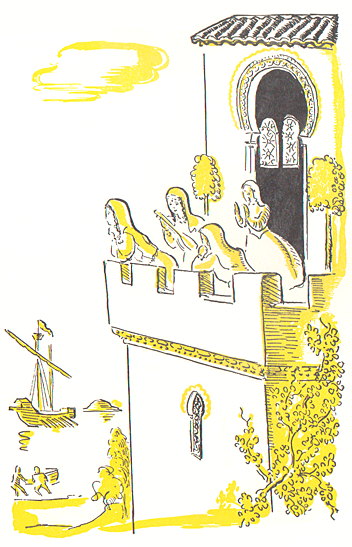

First |
Previous |
Next |
Last |
Book Index

|
Author: Washington Irving Copyright Date: 1953 Publisher: Macmillan Pagination: vii, 280 p. |
|
To the traveller imbued with the feeling for the historical and poetical, so inseparately intertwined in the annals of romantic Spain, the Alhambra is as much an object of devotion as is the Caaba to all true Moslems. How many legends and |
 |
traditions, true and fabulous, how many
songs and ballads, Arabian and Spanish, of love and war and chivalry, are associated with
this Oriental pile! It was the royal abode of the Moorish kings, where, surrounded with the splendours and refinements of
Asiatic luxury, they held dominion over what they vaunted as a terrestrial paradise, and made their last stand for empire in Spain.
The royal palace forms but a part of a fortress, the walls of which, studded with towers, stretch irregularly round the whole crest
of a hill, a spur of the Sierra Nevada or snowy mountains, and overlook the city; externally it is a rude congregation of towers and
battlements, with no regularity of plan nor grace of architecture, and giving little promise of
It was the royal abode of the Moorish kings, where, surrounded with the splendours and refinements of
Asiatic luxury, they held dominion over what they vaunted as a terrestrial paradise, and made their last stand for empire in Spain.
The royal palace forms but a part of a fortress, the walls of which, studded with towers, stretch irregularly round the whole crest
of a hill, a spur of the Sierra Nevada or snowy mountains, and overlook the city; externally it is a rude congregation of towers and
battlements, with no regularity of plan nor grace of architecture, and giving little promise of
 the grace and beauty which prevail within.
the grace and beauty which prevail within.In the time of the Moors the fortress was capable of containing within its outward precincts an army of forty thousand men, and served occasionally as a stronghold of the sovereigns against their rebellious subjects. After the kingdom had  passed into the hands of the Christians, the Alhambra continued to be a royal demesne, and was occasionally inhabited by the Castilian
monarchs. The emperor Charles V commenced a sumptuous palace within its walls, but was deterred from completing it by repeated shocks
and earthquakes. The last royal residents were Philip V and his beautiful queen, Elizabetta of Parma, early in the eighteenth century.
Great preparations were made for their reception. The palace and gardens were placed in a state of repair, and a new suite of apartments
erected, and decorated by artists brought from Italy. The sojourn of the sovereigns was transient, and after their departure the palace
once more became desolate.
passed into the hands of the Christians, the Alhambra continued to be a royal demesne, and was occasionally inhabited by the Castilian
monarchs. The emperor Charles V commenced a sumptuous palace within its walls, but was deterred from completing it by repeated shocks
and earthquakes. The last royal residents were Philip V and his beautiful queen, Elizabetta of Parma, early in the eighteenth century.
Great preparations were made for their reception. The palace and gardens were placed in a state of repair, and a new suite of apartments
erected, and decorated by artists brought from Italy. The sojourn of the sovereigns was transient, and after their departure the palace
once more became desolate.
|
||
First |
Previous |
Next |
Last |
Book Index